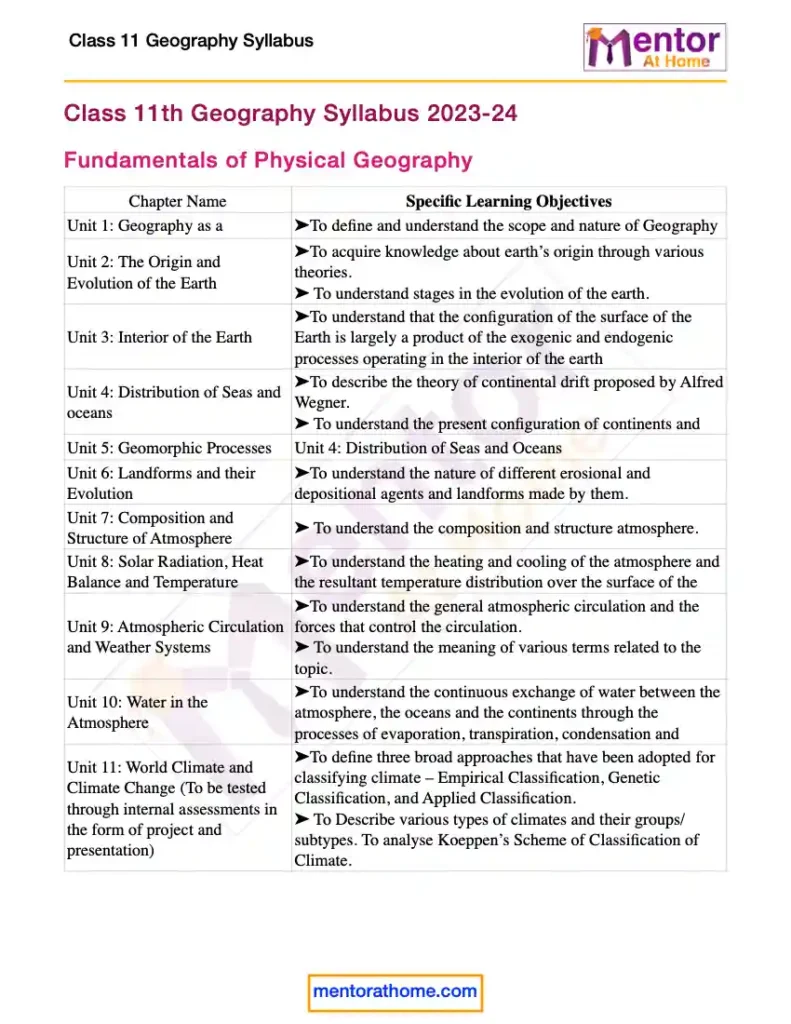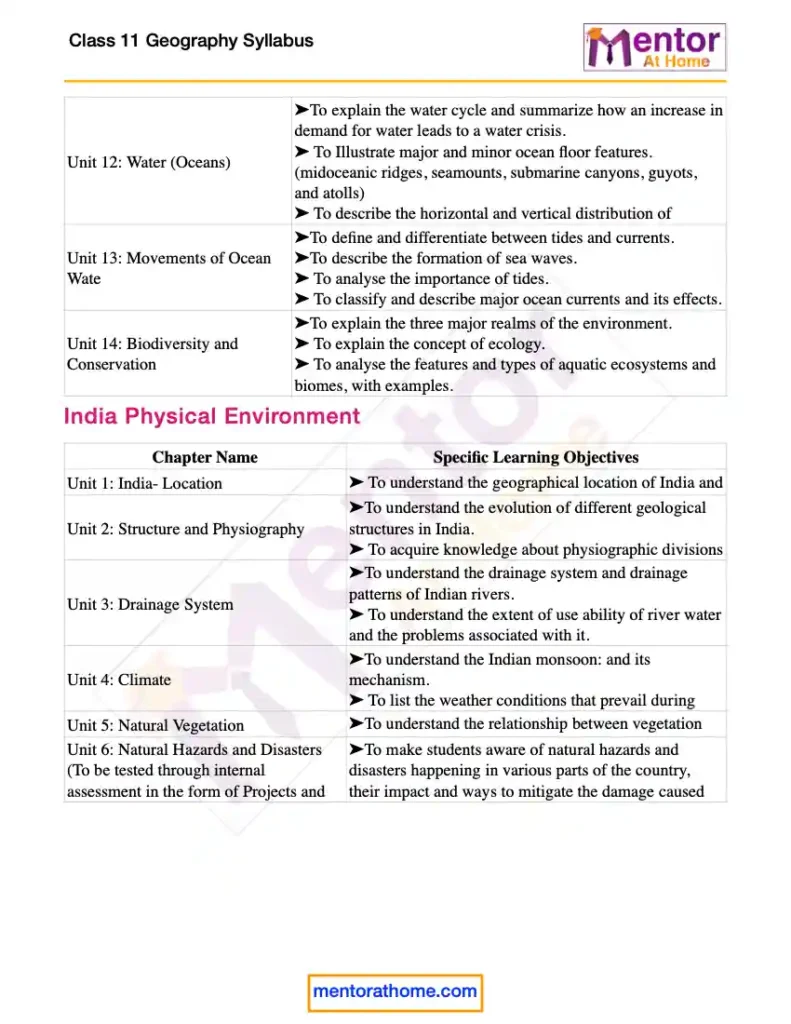Class 11th Geography Syllabus 2023-24
Here we provide the latest CBSE Class 11 Geography Syllabus 2023 24. You can also Download the new and revised CBSE Geography syllabus class 11 PDF. The present revised syllabus of class 11 Geography has been designed in accordance with National Curriculum Framework 2005.
Geography explores the relationship between people and their environment, it includes studies of physical and human environments and their interactions at different scales-local, state/region, nations and the world. CBSE Geography syllabus class 11 helps you understand the important topics. We advise you to read the CBSE class 11 Geography syllabus 2022 23 carefully. Class 11th Geography syllabus also helps you in preparation for competitive exams like UPSC etc.
You may also like
- Class 11 NCERT Solution
- Class 11 NCERT Books
- Class 11 NCERT Notes
- Class 11 Syllabus for all Subjects
CBSE Class 11 Geography Syllabus 2023-24 Pdf
Click here to download Class 11th Geography Syllabus Pdf
CBSE Class 11th Geography Syllabus 2023 24
The geography class 11 syllabus 2023-24 is given below.
Fundamentals of Physical Geography
| Chapter Name | Specific Learning Objectives |
|---|---|
| Unit 1: Geography as a Discipline | ➤To define and understand the scope and nature of Geography as a discipline |
| Unit 2: The Origin and Evolution of the Earth | ➤To acquire knowledge about earth’s origin through various theories. ➤ To understand stages in the evolution of the earth. |
| Unit 3: Interior of the Earth | ➤To understand that the configuration of the surface of the Earth is largely a product of the exogenic and endogenic processes operating in the interior of the earth |
| Unit 4: Distribution of Seas and oceans | ➤To describe the theory of continental drift proposed by Alfred Wegner. ➤ To understand the present configuration of continents and oceans through plate tectonics theory. |
| Unit 5: Geomorphic Processes | Unit 4: Distribution of Seas and Oceans |
| Unit 6: Landforms and their Evolution | ➤To understand the nature of different erosional and depositional agents and landforms made by them. |
| Unit 7: Composition and Structure of Atmosphere | ➤ To understand the composition and structure atmosphere. |
| Unit 8: Solar Radiation, Heat Balance and Temperature | ➤To understand the heating and cooling of the atmosphere and the resultant temperature distribution over the surface of the earth. |
| Unit 9: Atmospheric Circulation and Weather Systems | ➤To understand the general atmospheric circulation and the forces that control the circulation. ➤ To understand the meaning of various terms related to the topic. ➤ To know the causes and consequences of air circulation. |
| Unit 10: Water in the Atmosphere | ➤To understand the continuous exchange of water between the atmosphere, the oceans and the continents through the processes of evaporation, transpiration, condensation and precipitation. |
| Unit 11: World Climate and Climate Change (To be tested through internal assessments in the form of project and presentation) | ➤To define three broad approaches that have been adopted for classifying climate – Empirical Classification, Genetic Classification, and Applied Classification. ➤ To Describe various types of climates and their groups/subtypes. To analyse Koeppen’s Scheme of Classification of Climate. ➤ To explain climate change and related concepts. ➤ To evaluate the climate changes in the recent past. |
| Unit 12: Water (Oceans) | ➤To explain the water cycle and summarize how an increase in demand for water leads to a water crisis. ➤ To Illustrate major and minor ocean floor features. (midoceanic ridges, seamounts, submarine canyons, guyots, and atolls) ➤ To describe the horizontal and vertical distribution of oceanic temperature. ➤ To evaluate the factors affecting the salinity of ocean waters. |
| Unit 13: Movements of Ocean Wate | ➤To define and differentiate between tides and currents. ➤To describe the formation of sea waves. ➤ To analyse the importance of tides. ➤ To classify and describe major ocean currents and its effects. |
| Unit 14: Biodiversity and Conservation | ➤To explain the three major realms of the environment. ➤ To explain the concept of ecology. ➤ To analyse the features and types of aquatic ecosystems and biomes, with examples. |
India Physical Environment
| Chapter Name | Specific Learning Objectives |
|---|---|
| Unit 1: India- Location | ➤ To understand the geographical location of India and its significance. |
| Unit 2: Structure and Physiography | ➤To understand the evolution of different geological structures in India. ➤ To acquire knowledge about physiographic divisions and their subdivisions. |
| Unit 3: Drainage System | ➤To understand the drainage system and drainage patterns of Indian rivers. ➤ To understand the extent of use ability of river water and the problems associated with it. |
| Unit 4: Climate | ➤To understand the Indian monsoon: and its mechanism. ➤ To list the weather conditions that prevail during different seasons. ➤ To analyse the variation in the distribution of rainfall in India. |
| Unit 5: Natural Vegetation | ➤To understand the relationship between vegetation belts and the climate. |
| Unit 6: Natural Hazards and Disasters (To be tested through internal assessment in the form of Projects and presentation) | ➤To make students aware of natural hazards and disasters happening in various parts of the country, their impact and ways to mitigate the damage caused by them. |
NCERT Prescribed Textbook
- Fundamentals of Human Geography
- India – People and Economy
- Practical Work in Geography- Part II
Class 11 Geography Syllabus 2023- 24 – Course Structure
Before you read the Class 11th Geography syllabus you have to understand the course structure to complete the Geography syllabus of Class 11
| Part | Units | No. of Periods | Marks |
| A | Fundamentals of Physical Geography | 89 | 35 Marks |
| Unit-1: Geography as a discipline | 05 | 30 | |
| Unit-2: The Earth | 17 | ||
| Unit-3: Landforms | 18 | ||
| Unit-4: Climate | 26 | ||
| Unit-5: Water (Oceans) | 14 | ||
| Unit-6: Life on the Earth | 9 | ||
| Map and diagram | 05 | 5 | |
| B | India-Physical Environment | 78 | 35 Marks |
| Unit-7: Introduction | 5 | 30 | |
| Unit-8: Physiography | 32 | ||
| Unit-9: Climate and Natural Vegetation | 30 | ||
| Unit-10: Natural hazards and disasters | 6 | ||
| Map and Diagram | 5 | 5 | |
| Total | 167 | 70 Marks | |
| C | Practical Work in Geography Part I | 50 | 30 Marks |
| Unit-1: Fundamentals of Maps | 25 | 15 Marks | |
| Unit-2: Topographic Maps | 25 | 10 Marks | |
| Practical Record Book and Viva | 5 Marks |
Class 11th Geography Syllabus 2023-24- Objectives
The course in Geography will help learners to:
- Familiarize yourself with key concepts, terminology and core principles of Geography.
- Describe locations and correlate with Geographical Perspectives.
- List/describe what students might see, hear, and smell at a place.
- List/describe ways a place is linked with other places.
- Compare conditions and connections in one place to another.
- Analyse/ describe how conditions in one place can affect nearby places.
- identify regions as places that are similar or connected.
- Describe and interpret the spatial pattern features on a thematic map.
- Search for, recognize and understand the processes and patterns of the spatial arrangement of the natural features and human aspects and phenomena on the earth’s surface.
- Understand and analyse the inter-relationship between physical and human environments and utilize such knowledge in reflecting on issues related to the community.
- Apply geographical knowledge and methods of inquiry to emerging situations or problems at different levels-local, regional, national and global.
- Develop geographical skills, relating to collection, processing and analysis of spatial data/ information and preparation of reports including maps and graphs and use of computers where ever possible; and be sensitive to issues.
- The child will develop the competency to analyse, evaluate, interpret and apply the acquired knowledge to determine environmental issues effectively.


